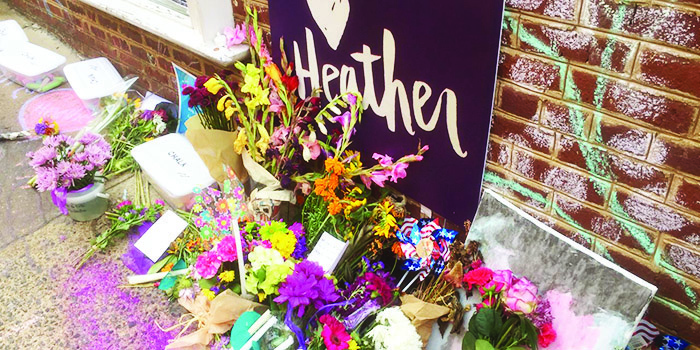
Charlottesville Struggles with Race, History and Survival

By CASH MICHAELS
CHARLOTTESVILLE, Va.—To say that Charlottesville, Va. held its collective breath on August 12th – the first anniversary of the deadly “Unite the Right” white supremacist violence a year ago that tragically took the life of Heather Heyer, a 32-year-old white anti-racist protestor, is an understatement.
Virginia Gov. Ralph Northam, and Charlottesville city officials, declared a state of emergency, mobilizing every available police officer and state trooper in an unyielding show of force, to preempt the kind of street clashes that infamously marked the Ku Klux Klan and skinhead demonstrations in August 2017.
Stung by withering criticism that law enforcement did little to quell the violence that erupted last year, officials virtually shut down the core Charlottesville downtown area for the August 10–August 12 weekend to vehicular traffic, and screened pedestrians for weapons.
Indeed, the “over-policing” this year, many residents complained, actually raised tensions, especially since the “Unite the Right” rally organizers moved their demonstration to Washington, D.C. this year.
Anti-racism protesters—most of whom were students from the University of Virginia at Charlottesville (UVA), bristled when a phalanx of state troopers, local police, hovering helicopters, and at one point, National Guardsmen with rifles and armored vehicles, flooded the corner of Fourth and Water streets downtown; the same corner where Heather Heyer was fatally struck by the car allegedly driven by a neo-Nazi.
There were intense verbal confrontations, and four arrests, but ultimately, no violence.
“Yes, there are some inconveniences, but we’d rather err on the side of safety this year,” said Councilman Wes Bellamy, who helped to calm tensions between demonstrators and police.
While church and civic groups sponsored numerous events to promote racial and spiritual harmony during the tragic August 12 anniversary, some residents were resentful, saying that Ms. Heyer may have been the only protester killed last year, but there were many other victims of White supremacist violence then as well who are rarely spoken of.
“I think that there’s a universal acceptance that what happened here was disgraceful,” civil rights activist Rev. Al Sharpton told reporters after preaching Sunday morning service at First Zion African Baptist Church. “But they do not want this to be representative of their city, and they want to move forward.”
And then there are the everyday challenges that many say are more important than removing Confederate statues.
Charlottesville is suffering many of the same struggles as other growing small and mid-size metropolitan areas, and those who consider themselves the working poor here say that not much is being done in the area of raising low wages, creating economic opportunities, or developing enough affordable housing stock for struggling families.
“They’re building all of the new homes and apartments for folks making six-figures,” said “Lloyd,” an independent cab driver who had to change professions in order to make ends meet.
For the first time in its history, Charlottesville has two African-Americans on its city council—Mayor Nikuyah Walker and Councilman Bellamy—both of whom were elected on the promise of improving the quality of life.
But talk with residents, like cab drivers who find themselves having to work seven-days a-week just to keep up with a spiraling cost of living in housing costs alone, and you get a sense of abandonment against the backdrop of the “haves” getting what they want, because they have those “six-figure salaries.”
For many Black residents, the racial history of Charlottesville strongly lends itself to a sense of oppression. Even Mayor Walker, during an appearance on CBS news analysis show “Face the Nation” Sunday.
“The issue is this deep-seated racism that we have here,” Mayor Walker said. “And that’s the challenge. And that’s a lot of work.”
And it doesn’t help that many believe the White power structure in Charlottesville, the home of Thomas Jefferson, caters to University of Virginia—arguably the largest employer in the city next to the hospital system. UVA is also an institution that was built on the backs of slaves.
Leaders like Councilman Bellamy, insist that progress is being made when it comes to planning for affordable housing, economic development, and even the hiring of more Black police officers (few were seen on patrol during the state of emergency).
But until that progress is seen, and felt, residents say the hard feelings surrounding race, and lack of forward mobility for the average working person in Charlottesville, will remain tragic anniversary after anniversary.